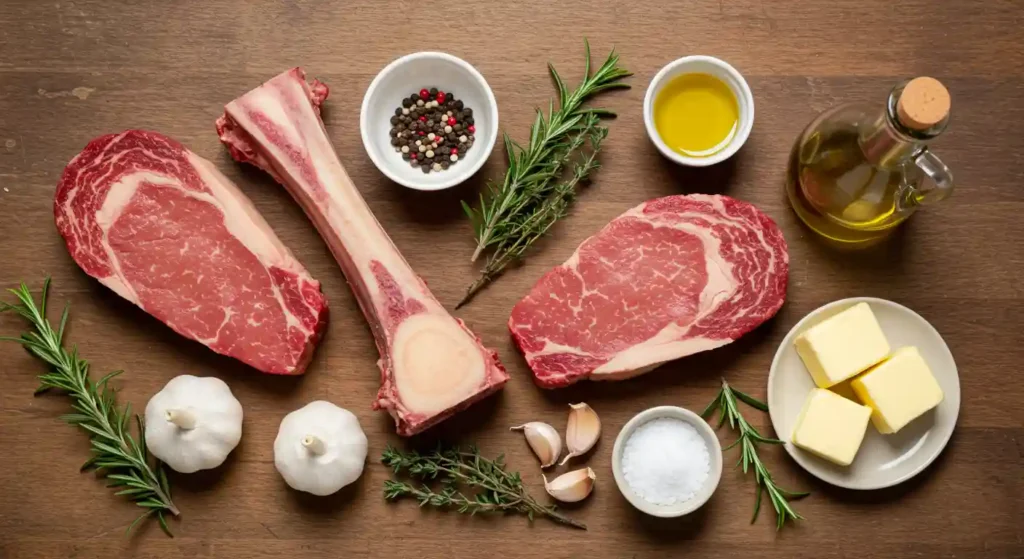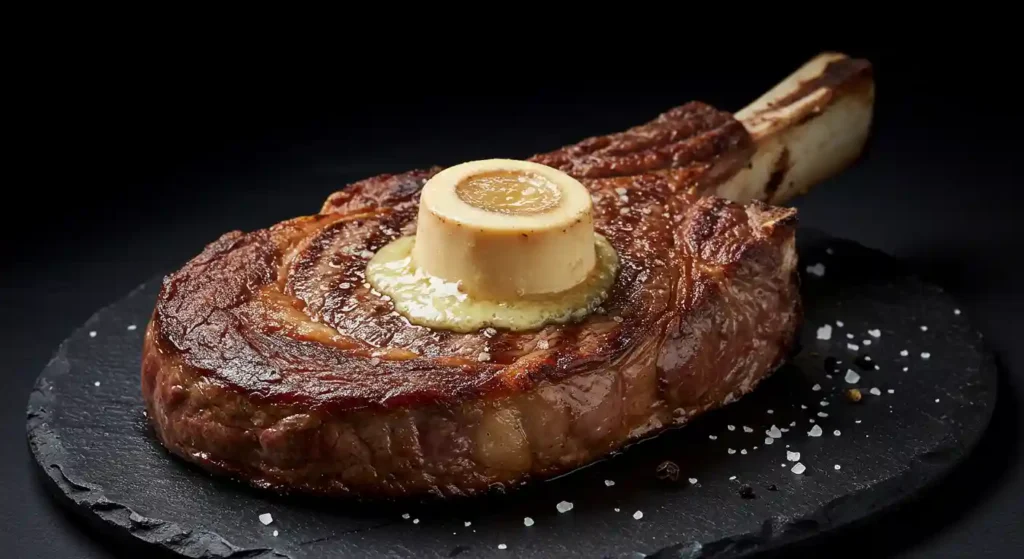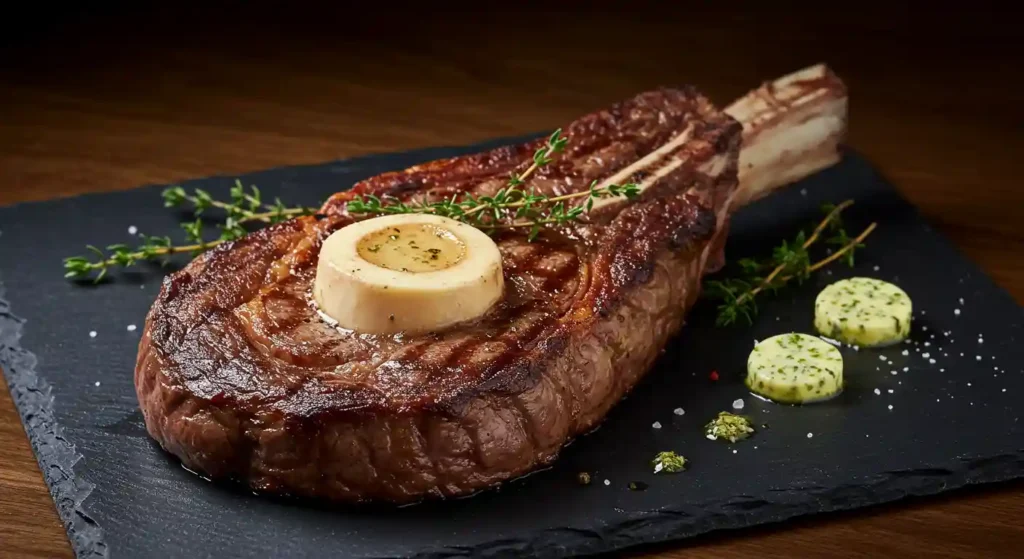ndulging in a perfectly cooked Ribeye steak is a decadent experience in itself, but when paired with bone marrow, it transforms into a sumptuous feast. Known for its rich, buttery texture and incredible depth of flavor, this combination is an unrivaled treat for those who appreciate fine dining. The marbled tenderness of Ribeye complements the melt-in-your-mouth essence of bone marrow, creating a culinary symphony that appeals to the senses.
The Ribeye steak, often hailed as one of the most luxurious cuts of beef, is renowned for its marbling and rich flavor profile. When combined with the indulgent richness of bone marrow, which has been celebrated in gourmet kitchens for centuries, it becomes a dish fit for royalty. Bone marrow has long been cherished in many culinary traditions, from European cuisine to modern fine dining, known for its delicate, buttery texture and its ability to elevate any dish with its decadent flavor.
I first encountered this luxurious pairing during a special dinner at a fine steakhouse, where the Ribeye arrived perfectly seared, and the bone marrow served alongside it added an unforgettable layer of richness. From that moment, it became my go-to for any celebration or special occasion, as the combination never fails to impress both my palate and guests.
Beyond the indulgence, this dish also offers nutritional benefits. Bone marrow is packed with collagen and healthy fats, contributing to joint health and supporting skin elasticity. This richness, both in flavor and nutrients, makes the Ribeye and bone marrow pairing a truly unique and satisfying culinary experience.
Table of Contents
Ingredients: The Building Blocks of a Decadent Ribeye and Bone Marrow Feast

To create this indulgent Ribeye steak paired with bone marrow, you’ll need high-quality ingredients that ensure rich flavor and an unforgettable experience. Here’s a detailed list of what you’ll need:
1. 2 Ribeye Steaks (Bone-In):
The star of the dish is the Ribeye steak, with its signature marbling of fat that ensures tenderness and richness when cooked. Bone-in Ribeyes add an extra level of flavor, as the bone imparts additional taste during the cooking process. For the best results, choose high-quality, grass-fed beef, which offers superior marbling and an unbeatable flavor.
2. 2 Marrow Bones (Split Lengthwise):
Bone marrow is the perfect accompaniment to Ribeye, bringing a melt-in-your-mouth buttery texture. Look for marrow bones that are split lengthwise, allowing the marrow to be easily accessed and roasted. For maximum richness, source your marrow bones from a trusted butcher who ensures high-quality cuts.
3. Salt and Pepper (for Seasoning):
Simple, but crucial. Salt and freshly cracked black pepper are vital for bringing out the natural flavors of the Ribeye steak and bone marrow. Opt for sea salt or kosher salt for seasoning.
4. Olive Oil or Butter (for Searing):
To sear the Ribeye steaks to perfection, you’ll need a high-smoke-point fat like olive oil or butter. Both work beautifully, but butter offers a more decadent, silky finish.
5. Fresh Herbs (such as Thyme or Rosemary):
Herbs like thyme and rosemary add aromatic notes that complement both the steak and the marrow. Fresh sprigs can be added to the pan while cooking for enhanced fragrance.
6. Garlic (Optional for Added Flavor):
If you love the deep, savory flavor of garlic, add a few crushed cloves to the pan when searing the steak. The garlic infuses the oil or butter, enriching the overall taste.
7. Additional Seasonings or Garnishes (Optional):
For an extra luxurious touch, consider finishing the dish with flaky sea salt or a drizzle of truffle oil. Both ingredients will elevate the flavor profile, taking your Ribeye and bone marrow to the next level.
Alternative Options:
- Vegan or Plant-Based Alternative:
If you’re looking for a plant-based version, try using a high-quality plant-based steak or mock protein (such as a seitan steak) for the Ribeye. For the marrow, you could try plant-based marrow alternatives, though the texture and flavor will be different. Consider using a rich vegan butter or oil in place of animal fats. - Gluten-Free or Low-Carb Diets:
This dish is naturally gluten-free, as both the Ribeye and bone marrow are free from gluten. For a low-carb side, consider pairing it with roasted vegetables or a fresh green salad, perfect for complementing the richness of the steak and marrow.
Ingredient Selection Tips for ribeye steak recipe
- Choose the Best Ribeye: Opt for grass-fed, well-marbled Ribeye steaks for the best flavor and texture. Grass-fed beef tends to be leaner but has a more robust, natural beef flavor compared to grain-fed beef.
- Source Quality Bone Marrow: When choosing marrow bones, select ones that are sourced from a reputable butcher or meat supplier. The marrow should be pale and creamy, indicating its richness and flavor.
- Fresh Herbs and Garlic for Extra Flavor: Fresh herbs like thyme and rosemary should be fragrant and vibrant. Similarly, select fresh garlic bulbs that are firm and free from any soft spots to ensure the best flavor.
With these ingredients and tips in hand, you’re ready to create a dish that’s both indulgent and memorable.
Instructions: Step-by-Step Guide to Cooking Ribeye Steak with Bone Marrow
Creating the perfect Ribeye steak paired with bone marrow requires a few essential steps to ensure you capture the full richness and flavor. Follow this guide to master the cooking process, and enjoy a decadent, melt-in-your-mouth meal.
Preparation
- Preheat Your Oven:
Start by preheating your oven to 400°F (200°C). This is the perfect temperature to finish off the Ribeye steaks after searing them. Set a timer to ensure your oven is fully heated before placing the steaks inside. - Bring Your Ribeye Steaks to Room Temperature:
While your oven is heating, remove the Ribeye steaks from the refrigerator and let them come to room temperature. This step helps the steaks cook more evenly, as they won’t experience a drastic temperature change when placed in the hot pan. Give this process about 20-30 minutes.
Searing the Ribeye
- Heat the Cast-Iron Skillet:
Heat a large cast-iron skillet over high heat until it becomes very hot.. Cast-iron is ideal for searing as it provides an even, intense heat, which is essential for creating a beautifully browned crust. - Add Olive Oil or Butter:
Once the skillet is hot, add a tablespoon of olive oil or butter. Let the fat heat up and start shimmering, but not smoking, to avoid burning it. - Season the Steaks:
While the skillet is heating, season both sides of the Ribeye steaks generously with salt and freshly cracked black pepper. This simple seasoning enhances the natural flavors of the beef and creates a flavorful crust when seared. - Sear the Steaks:
Carefully place the Ribeye steaks in the hot skillet. Sear for 3-4 minutes on one side without moving the steak, ensuring that a rich, golden-brown crust forms. Once that side is seared, flip the steak and sear the other side for another 3-4 minutes. Tip: For an extra layer of flavor, you can add a few sprigs of fresh thyme or rosemary to the skillet during the searing process. As the herbs heat up, they’ll infuse the oil and enhance the flavor of the meat.
Cooking the Bone Marrow butter
- Roast the Marrow Bones:
While the Ribeye steaks are searing, place the marrow bones in a separate baking dish or pan, cut-side up. Put them in the preheated oven and roast for about 15-20 minutes. The marrow should become soft, golden, and begin to pull away from the bone. When it’s ready, it will be rich and creamy, perfect for spreading on the steak. Tip: You’ll know the marrow is done when it starts to bubble at the edges and turns a golden color. This is when it releases the most flavor.
Finishing the Ribeye steak
- Finish the Steaks in the Oven:
After searing the Ribeye steaks, it’s time to finish cooking them in the oven. Place the skillet directly into the preheated oven and let the steaks cook for an additional 5-8 minutes, depending on your preferred level of doneness. For a medium-rare steak, aim for a target internal temperature of around 130-135°F (54-57°C). You can use a meat thermometer to check the internal temperature for accuracy. Tip: For perfect doneness, use a meat thermometer:
- Rare: 120-125°F (49-52°C)
- Medium-rare: 130-135°F (54-57°C)
- Medium: 140-145°F (60-63°C)
- Rest the Steaks:
Once your Ribeye steaks are done, remove them from the oven and let them rest on a cutting board or plate for about 5 minutes. This resting time allows the juices to redistribute throughout the steak, ensuring that it remains juicy and tender when sliced.
Assembly
- Top with Roasted Bone Marrow:
After your Ribeye has rested, it’s time to assemble the dish. Using a spoon, carefully scoop out the roasted bone marrow and spread it generously on top of the steak. The creamy, rich marrow will melt into the beef, creating a luxurious flavor. - Garnish and Serve:
For an extra touch of decadence, garnish your steak with fresh herbs like thyme or rosemary. If you want to elevate the dish even further, drizzle a bit of truffle oil on top for an aromatic, luxurious finish. Serve immediately, and enjoy the melt-in-your-mouth combination of flavors.
Tips for Perfect Cooking:
- Meat Thermometer: Use a meat thermometer for perfect doneness. It takes the guesswork out of the cooking process and ensures your steak is cooked to your preference.
- Rest the Steak: Letting the Ribeye rest is crucial. It ensures that the steak retains its juices and remains tender and flavorful.
- Roast the Marrow Thoroughly: Roast the marrow bones until they are bubbling and golden. This allows the marrow to soften fully, releasing its deep, rich flavor.
By following these instructions, you’ll create a memorable Ribeye steak and bone marrow dish that combines luxurious flavor with expert cooking techniques.
Tips & Variations: Elevating Your Ribeye and Bone Marrow Experience

Adapting for Different Diets
- Keto-Friendly or Paleo:
If you’re following a keto or paleo diet, the Ribeye and bone marrow combination is already a perfect match, as both are low in carbohydrates and rich in healthy fats. For a complementary side, consider serving the steak with roasted vegetables such as Brussels sprouts, zucchini, or asparagus. A creamy cauliflower mash can replace mashed potatoes, offering a low-carb, rich alternative that complements the dish’s flavors. - Lean Protein Option:
If you’re looking for a leaner cut of meat, you can substitute the Ribeye with tenderloin or sirloin. These cuts are less fatty but still offer good tenderness. Keep in mind that while the flavor won’t be as rich as Ribeye, you can boost the taste by adding additional herbs or seasoning to the meat. A leaner steak, however, won’t deliver the same buttery, melt-in-your-mouth quality when paired with the marrow.
Ideas for New Flavors or Improvements
- Lemon Juice:
For an unexpected burst of freshness that contrasts beautifully with the richness of the bone marrow, squeeze a bit of lemon juice over the marrow just before serving. This will add a zesty contrast that brightens the dish and balances its decadence. - Herb-Infused Bone Marrow:
To take the flavor of the marrow to the next level, try infusing it with herbs while roasting. Add a sprig or two of rosemary or thyme to the marrow bones before they go into the oven. The herbs will impart a subtle, aromatic flavor that complements both the steak and marrow.
Suggestions for Serving
- Wine Pairing:
A rich red wine is the perfect accompaniment to this dish. A Cabernet Sauvignon or Malbec will complement the bold flavors of the Ribeye and bone marrow, enhancing the overall dining experience. The tannins in these wines cut through the richness, creating a harmonious balance. - Side Dishes:
To balance the richness of the steak and marrow, serve with a side of roasted potatoes or a light arugula salad. The peppery arugula offers a fresh contrast to the richness, while the potatoes provide a comforting, savory pairing.
By incorporating these tips and variations, you can customize your Ribeye steak and bone marrow dish to fit different dietary preferences or add your own personal touch, making it even more enjoyable for you and your guests.
Nutritional Information: Ribeye Steak with Bone Marrow recipe
A serving of Ribeye steak paired with bone marrow is not only a luxurious treat but also provides several key nutrients that can benefit your health. Here’s a detailed breakdown of the nutritional content for this indulgent dish:
Calories and Macronutrients:
- Calories per serving (steak + marrow):
Approximately 600-700 calories, depending on the size of the steak and the amount of marrow used. - Fat:
Around 40-50g of fat per serving. This includes healthy fats from the bone marrow, which is known for its richness in unsaturated fats and omega-3s, as well as saturated fats from the Ribeye steak. The fat from marrow is particularly beneficial, offering a smooth, buttery texture and contributing to its decadent flavor. - Protein:
A typical serving will provide about 50-60g of protein, primarily from the Ribeye steak. This makes it an excellent source of high-quality protein, which is essential for muscle repair, growth, and overall body function. Ribeye steaks are particularly rich in essential amino acids like leucine, which supports muscle building and repair. - Carbohydrates:
This dish contains virtually no carbohydrates, making it suitable for low-carb and keto diets. The combination of Ribeye and marrow is naturally free from carbs, allowing you to indulge without worrying about impacting blood sugar levels.
Health Benefits of Key Ingredients for grilled ribeye steak
- Bone Marrow:
Bone marrow is rich in collagen, which plays a vital role in maintaining joint health, improving skin elasticity, and supporting healthy connective tissue. Collagen also aids in reducing the appearance of fine lines and wrinkles, promoting smoother, younger-looking skin. Additionally, the marrow is a great source of healthy fats that are beneficial for brain and heart health. - Ribeye Steak:
Ribeye steak is packed with protein and essential amino acids, which are crucial for building and repairing tissues in the body. The iron content in Ribeye also helps in improving oxygen transport in the blood, while zinc supports a healthy immune system. - Fresh Herbs (e.g., Thyme):
Fresh herbs like thyme are loaded with antioxidants, which help fight oxidative stress and may reduce inflammation in the body. Incorporating these herbs into your dish not only boosts flavor but also adds health benefits to your meal.
In conclusion, while Ribeye steak with bone marrow is a calorie-dense dish, it provides an abundance of nutrients, from high-quality protein to healthy fats and beneficial compounds like collagen and antioxidants. It’s a meal that not only satisfies the taste buds but also supports your overall health.
Common Mistakes & Fixes: Ensuring a Perfect Ribeye and Bone Marrow Dish
While preparing Ribeye steak with bone marrow is a straightforward process, there are a few common pitfalls that can affect the outcome. Here are some of the most frequent mistakes, along with solutions to ensure you get it just right:
1. Overcooking the Ribeye Steak
Mistake:
Overcooking the Ribeye steak is one of the most common mistakes when preparing this dish. As Ribeye is a fatty cut of beef, it benefits from a quick sear and finishing in the oven to preserve its tenderness and juiciness. However, if left in the oven for too long or seared for too many minutes, it can easily become dry and tough.
Fix:
TTo prevent overcooking, use a meat thermometer to monitor the internal temperature, Aim for these temperatures based on your preferred level of doneness:
- Rare: 120-125°F (49-52°C)
- Medium-rare: 130-135°F (54-57°C)
- Medium: 140-145°F (60-63°C)
Remove the steak from the oven once it reaches your desired temperature and allow it to rest for 5 minutes before serving to let the juices redistribute.
If your steak is already overcooked, consider slicing it thinly and serving it in smaller portions, with the rich, creamy marrow as a topping. This can help balance the texture and flavors, making the steak more enjoyable.
2. Undercooking the Bone Marrow
Mistake:
Bone marrow can be tricky to cook, and undercooking it is a common error. If the marrow is too firm or not fully roasted, it can be difficult to scoop out and might lack the rich, buttery texture that makes it such a delightful addition to the steak.
Fix:
To ensure the marrow is thoroughly roasted, check its texture as it cooks. It should be soft, golden, and easily scoopable. If it’s still too firm after 15-20 minutes, return it to the oven for an additional 5-10 minutes until it reaches a melt-in-your-mouth consistency. You can also baste it with the juices from the pan to enhance the flavor while roasting.
Bonus Tip:
To avoid any issues with either the steak or marrow, keep a close eye on both during the cooking process and use a timer. This helps ensure optimal doneness for both elements of the dish, making your Ribeye steak with bone marrow a delicious success every time.
FAQs: Ribeye Steak with Bone Marrow

How can this recipe be stored?
Store any leftovers in an airtight container in the refrigerator for up to 2 days, When reheating, it’s best to gently warm the Ribeye steak in a low-heat oven to preserve its tenderness. For the bone marrow, you can reheat it in the oven at a low temperature or use the microwave. To maintain the flavor and texture, avoid reheating it too aggressively.
Can this recipe be made ahead of time?
Yes, you can prepare bone marrow ahead of time. Roast the marrow bones and allow them to cool, then store them in the fridge for up to 2 days. When ready to serve, simply reheat them in the oven until they become soft and creamy again. However, it’s best to cook the Ribeye steak just before serving to preserve its juiciness and tenderness. Cooking the steak in advance can cause it to dry out, so leave that step to the last minute.
What are the best add-ons or variations for this recipe?
To elevate the flavors of this dish, you can try a few add-ons or variations:
- Balsamic Glaze:
A drizzle of balsamic glaze over the Ribeye adds a touch of sweetness and tanginess that beautifully contrasts with the richness of the steak and marrow. - Side Dishes:
Pair the steak with a side of crispy Brussels sprouts, which provide a crispy texture and slight bitterness that balances the richness of the meat and marrow. Alternatively, a light arugula salad with a citrus vinaigrette works as a fresh, peppery contrast. - Truffle Oil:
For an even more decadent twist, you can drizzle a little truffle oil over the steak before serving. This will add an earthy, luxurious flavor to your meal.
By experimenting with these variations, you can customize the dish to suit your preferences and make each meal unique!
Conclusion & Call to Action
There’s no denying that Ribeye steak with bone marrow offers a truly luxurious, decadent experience. The tender, richly marbled steak combined with the creamy, melt-in-your-mouth marrow creates a dish that is perfect for special occasions or simply when you want to treat yourself to something extraordinary. It’s a meal that’s sure to impress and satisfy even the most discerning palate.
We’d love to hear about your experience making this indulgent dish! Share your thoughts, modifications, or any creative twists you added to the recipe in the comments below. Your insights might inspire fellow food enthusiasts to try new variations and make this dish even better.
If you’re craving more gourmet steak recipes, be sure to check out other indulgent meals on the blog. You might enjoy a The Exemplar Steak Fettuccine : With Garlic Butter Sauce – Pure Indulgence, or perhaps a Legendary Tomahawk Steak. No matter which recipe you choose, you’re in for a treat!
Don’t wait—dive into the world of gourmet flavors with these delicious dishes and elevate your next meal to something truly special!


4 thoughts on “How to Cook Ribeye Steak With Bone Marrow That Will Blow Your Mind”
Comments are closed.